If you even remotely follow the development of digital photography technology, you could not have missed that one of the basic parameters – resolution – has slowly and continually been improving. This year, and apparently for the first time in history, the opposite took place: for its flagship product among compact cameras, model PowerShot G11, Canon used a sensor with a lower resolution than its predecessor, the G10.
First of all, let’s get briefly acquainted with the ‘Gees’, one of the product lines of Canon’s compact digitals. From the very beginning of the development of the PowerShots G, from the G1, which was introduced to the market in 2000, they have represented the most advanced cameras in compact design both within their own brand as well as amongst their competition. The Gees have always excelled and still excel with brilliant image quality, excellent technical features, and advanced functions. As a result, they have never been cheap but they represent a sort of backup camera line for semiprofessional and professional photographers working with digital reflex cameras. The next to last Gee featured a respectable resolution of 14.7 Mpx. But the newest PowerShot G11 has ‘only’ 10 Mpx. Why this change to three generations previous (G10 had 12 MPx, G8 never existed and only G7 had 10 Mpx)?
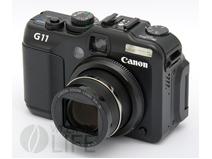 |
 |
Compact digital cameras have one major disadvantage – they have very small sensors (with sizes roughly in millimeters as opposed to the tens of millimeters of D-SLR or Micro 4/3) and miniature individual cells. This is why they are unable to generate a strong charge and why disturbing digital noise occurs easily and quickly. Thus, whereas many reflex cameras produce nearly noise-free images when using ISO 800 sensitivity, images from the majority of digital compacts, despite the high resolution, can be used only for small photographs, where the noise is lost. In other words, increasing resolution of digital compact cameras while maintaining sensor size is detrimental.
Canon is surely aware of this, and in case of G11 the company disregarded marketing pressure for higher resolution – the 10 Mpx is a whole lot of data – and devoted their efforts to improving image quality instead. As you will discover at the conclusion of this review and as you can see in the sample photographs, it succeeded in this endeavor very well.
 |
||||||||
|
||||||||
Canon G11 is a robust compact and its dimensions approach cameras of the Micro 4/3 standard (see e.g. our reviews of Olympus Pen E-P1 or Panasonic Lumix DMC-GF1 ). But thanks to a larger body one has a better grip and the number of buttons and other features spread out on the body are controlled easily. With a weight of 400 grams you will also be thankful for the classic neck strap instead of the usual ‘compact’ hand loop.
It is also one of the last few digital compacts still equipped with an optical sight viewfinder that is unfortunately small and not quite usable.
 |
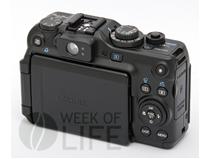 |
Other than the optical viewfinder, the Canon G11 is of course fitted with a large display on the back side – in this case on a hinge, which enables one to not only tilt it by nearly ninety degrees but also to rotate it by three quarters of a full circle, 270 degrees. Thanks to this you can comfortably photograph from various breakneck positions and also turn the display face inside for safer transport, and so forth.
In the case of the LCD, Canon actually went back several generations of Gees, as the last model fitted with such a display was the PowerShot G6, introduced at the end of 2004. But it had a small two-inch display, whereas the G11 uses an LCD with a diagonal size nearly one inch larger with fourfold higher resolution.
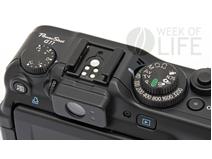 |
||||||
|
The Canon PowerShot G11 has a large number of advanced functions and after the fashion of reflex cameras for demanding photographers, the handling is designed in such a way as to allow the most important parameters to be changed very quickly. Controls for direct access to functions, which are dispersed literally over the whole top and back side of the camera serve this purpose.
 |
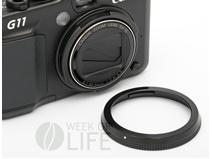 |
Notice in particular the ‘analog’ circular controls at the top. At the very left you will find exposure correction in the range ±2 EV, sectioned in thirds of the exposure level. Right from the flash hot shoe you can find a doubled circular select switch, where the larger bottom circular ring controls ISO sensitivity and the smaller wheel sets exposure programs. Here you will also find the C1 and C2 options, which are two Custom user regimes, where you can define your own settings in a wide range of functions, including, for example, the zoom focal length.
The right back side of the camera next to the display features the usual arrangement of buttons and a four-way select switch with a rotating circular ring. Operating Canon G11 is by and large very straightforward and fast. A button on the back side under exposure correction, which can be configured by the user, is another aspect that contributes to this. You can see the number of functions, which can be chosen and set for the button, in the last example of the camera menu below.
 |
 |
Again after the fashion of advanced digital reflex cameras, the Canon G11 has been given a high degree of modularity – options for user extensions. The circular ring around the lens is removable. Under it you will find a bayonet similar to the one for mounting lenses with reflex cameras. An additional, supplied, adapter lens barrel can be mounted on it which can in turn be used to mount various photographic filters or, for instance, a 1.4× teleconverter. The adapter barrel is also compatible with circular macro flashes by Canon. Common external flashes can be of course mounted on the hot shoe at the top of the camera. Especially with the small flash Canon Speedlite 270EX, the configuration is still sufficiently compact, yet it excels with high light output even in very difficult conditions.
Examples of the camera menu of Canon PowerShot G11
 |
 |
 |
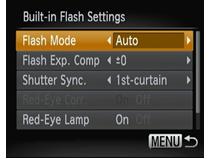 |
 |
Overall evaluation
Without exaggeration, the Canon PowerShot G11 represents the best compact digital camera in the market at the end of 2009. By keeping a reasonable resolution and thus also size of the individual cells of the sensor, and by developing excellent algorithms for reducing noise as well, Canon has created a compact camera that beats all its competitors with regard to noise level. Related to this is a traditionally outstanding lens that delivers very sharp images without optical defects. The Canon G11 is well equipped with functions – both beginners who use automatic modes as well as semiprofessionals and professionals, who prefer aperture priority, shutter priority, or fully manual settings will find what they need. A camera of this sort would not be without the RAW format, which allows many subsequent computer adjustments that can be made without damaging the quality of the image file.
Common price (at the time of this review being published): $ 499, € 589, £ 569
Basic technical data for Canon PowerShot G11
Sensor
CCD 1/1.7″
10 Mpx (3 648 × 2 736 px)
Sensitivity ISO 80 to 3,200
Optics
28–140 mm F2.8–4.5
Optical stabilization
Memory medium
SD/SDHC
Data formats
Image: JPEG, RAW (CR2)
Video: MOV
Video
640 × 480 px, 30 fps
320 × 240 px, 30 fps
Mono sound
LCD
Screen size 2.8″ (71 mm)
461,000 px
Power supply
Li-Ion battery
Dimensions and weight
113 × 79 × 48 mm (w × h × d)
400 g (incl. battery and memory card)
 |
 |
 |
 |
 |
 |
 |
 |
 |
 |
 |
 |
 |
 |
 |
